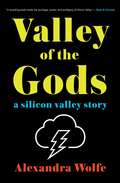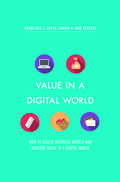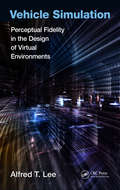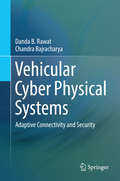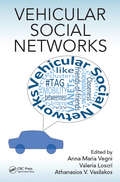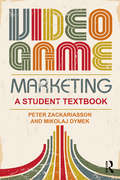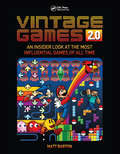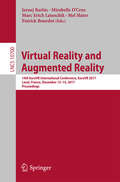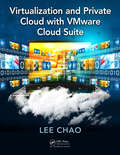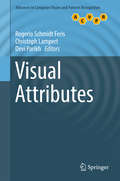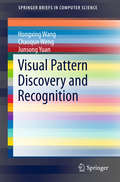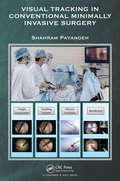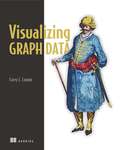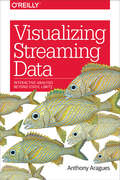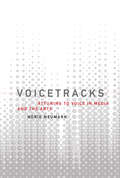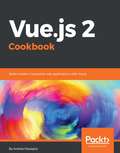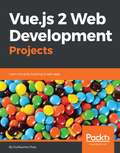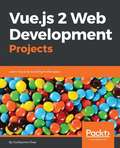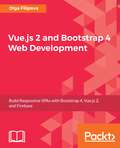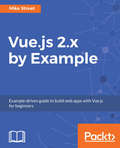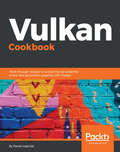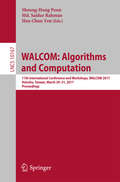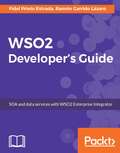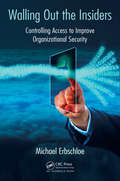- Table View
- List View
Valley of the Gods: A Silicon Valley Story
by Alexandra WolfeIn a riveting, hilarious account, reporter Alexandra Wolfe exposes a world that is not flat but bubbling—the men and women of Silicon Valley, whose hubris and ambition are changing the world.Each year, young people from around the world go to Silicon Valley to hatch an idea, start a company, strike it rich, and become powerful and famous. In The Valley of the Gods, Wolfe follows three of these upstarts who have “stopped out” of college and real life to live and work in Silicon Valley in the hopes of becoming the next Mark Zuckerberg or Elon Musk. No one has yet documented the battle for the brightest kids, kids whose goals are no less than making billions of dollars—and the fight they wage in turn to make it there. They embody an American cultural transformation: A move away from the East Coast hierarchy of Ivy Leagues and country clubs toward the startup life and a new social order. Meet the billionaires who go to training clubs for thirty-minute “body slams” designed to fit in with the start-up schedule; attend parties where people devour peanut butter-and-jelly sushi rolls; and date and seduce in a romantic culture in which thick glasses, baggy jeans, and a t-shirt is the costume of any sex symbol (and where a jacket and tie symbolize mediocrity). Through Wolfe’s eyes, we discover how they date and marry, how they dress and live, how they plot and dream, and how they have created a business world and an economic order that has made us all devotees of them. A blistering, brilliant, and hysterical examination of this new ruling class, The Valley of the Gods presents tomorrow’s strange new normal where the only outward signs of tech success are laptops and ideas.
Value in a Digital World
by Francisco J. López Lubián José EstevesAn in-depth examination of the concept of value in a digital world, an analysis of a range of digital business models and a framework for assessing the value of digital businesses. Assessing the value of traditional business was easy. There are hard, well tested metrics and tangible, measurable assets you can literally kick the tyres of. But how do you measure the value of something that consists of little more than bits of information, brand awareness and a compelling idea? In the winner takes all digital world how do you know if this idea is one that will attract billions of dedicated users or a few thousand fleeting trialists? And, most importantly, how do you assess whether any given business model is robust enough to make billions or flawed in a way that will lose millions? Lopez Lubian and Esteves look at what economic value means in a digital world, and argue for a shift from traditional value metrics to digital value metrics. Through high profile case studies they examine the process of valuation in the digital world – examining the challenges of making objective judgments from subjective information and how to assess the value of data. Next they analyse in depth a number of different digital business models from the perspective of delivering value to investors, stakeholders and society at large. Finally they present a framework model for assessing value in digital business.
Vehicle Simulation: Perceptual Fidelity in the Design of Virtual Environments
by Alfred T. LeeThis book covers the problem of fidelity in the design of virtual environments with specific reference to the design of vehicle simulators. The default design goal has been on the physical replication of a given real-world environment and, in the case of vehicles, the specific appearance and function of vehicle components. This book discusses that perceptual, rather than physical, fidelity of a virtual environment, should be the design goal and the principal purpose is to produce human behavior. This book provides the rationale and design guidance to maximize perceptual fidelity in the development of virtual environments, and therefore maximize the costeffectiveness as well.
Vehicular Cyber Physical Systems
by Danda B. Rawat Chandra BajracharyaThis book provides probabilistic, deterministic and geolocation-aware approaches for adaptive connectivity, robust security and privacy-aware communications for vehicular cyber physical systems (CPS). It presents mathematical models and numerical results obtained from experiments and simulations, and a trade-off between connectivity, security and privacy for vehicular communications. Connectivity between vehicles is crucial for vehicular CPS. Intelligent vehicular CPS provides not only road safety and traffic efficiency by exchanging information among vehicles, but also offers infotainment services to passengers using a variety of wireless technologies to forward the traffic/trajectory information with Vehicle-to-Vehicle (V2V), vehicular ad hoc network (VANET), and Vehicle-to-Roadside-to-Vehicle (V2R2V) communications. The book covers how to ensure that the message received from other vehicles is secure and trustworthy, rather than malicious. Further, it reveals how to make sure that the privacy of participants is not revealed while validating the received message. Researchers and professionals working with vehicular networks, smart systems, cyber physical systems, and mobile privacy will find this book valuable.
Vehicular Social Networks
by Anna Maria Vegni; Valeria Loscrí; Athanasios V. VasilakosThe book provides a comprehensive guide to vehicular social networks. The book focuses on a new class of mobile ad hoc networks that exploits social aspects applied to vehicular environments. Selected topics are related to social networking techniques, social-based routing techniques applied to vehicular networks, data dissemination in VSNs, architectures for VSNs, and novel trends and challenges in VSNs. It provides significant technical and practical insights in different aspects from a basic background on social networking, the inter-related technologies and applications to vehicular ad-hoc networks, the technical challenges, implementation and future trends.
Video Game Marketing: A student textbook
by Peter Zackariasson Mikolaj DymekThe video game industry has been one of the fastest-growing cultural phenomena of our times with market conditions that demand a specific skill set from its marketers. To a new generation of "indie gamers", being a game developer isn’t just about design and production, a successful video game demands entrepreneurial skills and astute business acumen. The creators need to know what their customers want, how to reach those customers and how to sell to them. Video Game Marketing: A student textbook is for development students or aspiring developers who want to know how to promote and sell the results of their efforts. This book is a much-needed guide to: • the essentials of marketing strategy; • video games as products or services; • marketing research for game development; • branding video games; • marketing through game: gamification, advergames. Replete with pedagogy to aid learning such as objectives and discussion questions for each chapter, this book is all that aspiring video game developers will need to unleash the potential of their games.
Vintage Games 2.0: An Insider Look at the Most Influential Games of All Time
by Matt BartonSuper Mario Bros. Doom. Minecraft. It’s hard to imagine what life would be like today without video games, a creative industry that now towers over Hollywood in terms of both financial and cultural impact. The video game industry caters to everyone, with games in every genre for every conceivable electronic device--from dedicated PC gaming rigs and consoles to handhelds, mobile phones, and tablets. Successful games are produced by mega-corporations, independent studios, and even lone developers working with nothing but free tools. Some may still believe that video games are mere diversions for children, but today’s games offer sophisticated and wondrously immersive experiences that no other media can hope to match. Vintage Games 2.0 tells the story of the ultimate storytelling medium, from early examples such as Spacewar! and Pong to the mind blowing console and PC titles of today. Written in a smart and engaging style, this updated 2nd edition is far more than just a survey of the classics. Informed by hundreds of in-depth personal interviews with designers, publishers, marketers, and artists--not to mention the author’s own lifelong experience as a gamer--Vintage Games 2.0 uncovers the remarkable feats of intellectual genius, but also the inspiring personal struggles of the world’s most brilliant and celebrated game designers--figures like Shigeru Miyamoto, Will Wright, and Roberta Williams. Ideal for both beginners and professionals, Vintage Games 2.0 offers an entertaining and inspiring account of video game’s history and meteoric rise from niche market to global phenomenon. Credit for the cover belongs to Thor Thorvaldson.
Virtual Reality and Augmented Reality: 14th EuroVR International Conference, EuroVR 2017, Laval, France, December 12–14, 2017, Proceedings (Lecture Notes in Computer Science #10700)
by Jernej Barbic, Mirabelle D'Cruz, Marc Erich Latoschik, Mel Slater and Patrick BourdotThis book constitutes the refereed proceedings of the 14th International Conference on Virtual Reality and Augmented Reality, EuroVR 2017, held in Laval, France, in December 2017.The 10 full papers and 2 short papers presented were carefully reviewed and selected from 36 submissions. The papers are organized in four topical sections: interaction models and user studies, visual and haptic real-time rendering, perception and cognition, and rehabilitation and safety.
Virtualization and Private Cloud with VMware Cloud Suite
by Lee ChaoTo help readers understand virtualization and cloud computing, this book is designed to cover the theories and concepts enough to understand the cutting-edge technology. Meanwhile, in this book, the reader can gain hands-on skills on VMware Cloud Suite to create a private cloud. With the academic support from VMware, readers can use the VMware supported software to create various virtualized IT infrastructures sophisticated enough for various sized enterprises. Then, the virtualized IT infrastructure can be made available to an enterprise through the private cloud services.
Visual Attributes
by Rogerio Schmidt Feris Christoph Lampert Devi ParikhThis unique text/reference provides a detailed overview of the latest advances in machine learning and computer vision related to visual attributes, highlighting how this emerging field intersects with other disciplines, such as computational linguistics and human-machine interaction. Topics and features: presents attribute-based methods for zero-shot classification, learning using privileged information, and methods for multi-task attribute learning; describes the concept of relative attributes, and examines the effectiveness of modeling relative attributes in image search applications; reviews state-of-the-art methods for estimation of human attributes, and describes their use in a range of different applications; discusses attempts to build a vocabulary of visual attributes; explores the connections between visual attributes and natural language; provides contributions from an international selection of world-renowned scientists, covering both theoretical aspects and practical applications.
Visual Pattern Discovery and Recognition
by Junsong Yuan Hongxing Wang Chaoqun WengThis book presents a systematic study of visual pattern discovery, from unsupervised to semi-supervised manner approaches, and from dealing with a single feature to multiple types of features. Furthermore, it discusses the potential applications of discovering visual patterns for visual data analytics, including visual search, object and scene recognition. It is intended as a reference book for advanced undergraduates or postgraduate students who are interested in visual data analytics, enabling them to quickly access the research world and acquire a systematic methodology rather than a few isolated techniques to analyze visual data with large variations. It is also inspiring for researchers working in computer vision and pattern recognition fields. Basic knowledge of linear algebra, computer vision and pattern recognition would be helpful to readers.
Visual Tracking in Conventional Minimally Invasive Surgery
by Shahram PayandehVisual Tracking in Conventional Minimally Invasive Surgery introduces the various tools and methodologies that can be used to enhance a conventional surgical setup with some degree of automation. The main focus of this book is on methods for tracking surgical tools and how they can be used to assist the surgeon during the surgical operation. Various notions associated with surgeon–computer interfaces and image-guided navigation are explored, with a range of experimental results. The book starts with some basic motivations for minimally invasive surgery and states the various distinctions between robotic and non-robotic (conventional) versions of this procedure. Common components of this type of operation are presented with a review of the literature addressing the automation aspects of such a setup. Examples of tracking results are shown for both motion and gesture recognition of surgical tools, which can be used as part of the surgeon–computer interface. In the case of marker-less tracking, where no special visual markers can be added to the surgical tools, the tracking results are divided into two types of methodology, depending on the nature and the estimate of the visual noise. Details of the tracking methods are presented using standard Kalman filters and particle filters. The last part of the book provides approaches for tracking a region on the surgical scene defined by the surgeon. Examples of how these tracking approaches can be used as part of image-guided navigation are demonstrated. This book is designed for control engineers interested in visual tracking, computer vision researchers and system designers involved with surgical automation, as well as surgeons, biomedical engineers, and robotic researchers.
Visualizing Graph Data
by Corey LanumSummaryVisualizing Graph Data teaches you not only how to build graph data structures, but also how to create your own dynamic and interactive visualizations using a variety of tools. This book is loaded with fascinating examples and case studies to show you the real-world value of graph visualizations. Purchase of the print book includes a free eBook in PDF, Kindle, and ePub formats from Manning Publications.About the TechnologyAssume you are doing a great job collecting data about your customers and products. Are you able to turn your rich data into important insight? Complex relationships in large data sets can be difficult to recognize. Visualizing these connections as graphs makes it possible to see the patterns, so you can find meaning in an otherwise over-whelming sea of facts.About the BookVisualizing Graph Data teaches you how to understand graph data, build graph data structures, and create meaningful visualizations. This engaging book gently introduces graph data visualization through fascinating examples and compelling case studies. You'll discover simple, but effective, techniques to model your data, handle big data, and depict temporal and spatial data. By the end, you'll have a conceptual foundation as well as the practical skills to explore your own data with confidence.What's InsideTechniques for creating effective visualizationsExamples using the Gephi and KeyLines visualization packagesReal-world case studiesAbout the ReaderNo prior experience with graph data is required.About the AuthorCorey Lanum has decades of experience building visualization and analysis applications for companies and government agencies around the globe.Table of ContentsPART 1 - GRAPH VISUALIZATION BASICSGetting to know graph visualizationCase studiesAn introduction to Gephi and KeyLinesPART 2 VISUALIZE YOUR OWN DATAData modelingHow to build graph visualizationsCreating interactive visualizationsHow to organize a chartBig data: using graphs when there's too much dataDynamic graphs: how to show data over timeGraphs on maps: the where of graph visualization
Visualizing Streaming Data: Interactive Analysis Beyond Static Limits
by Anthony AraguesWhile tools for analyzing streaming and real-time data are gaining adoption, the ability to visualize these data types has yet to catch up. Dashboards are good at conveying daily or weekly data trends at a glance, though capturing snapshots when data is transforming from moment to moment is more difficult—but not impossible.With this practical guide, application designers, data scientists, and system administrators will explore ways to create visualizations that bring context and a sense of time to streaming text data. Author Anthony Aragues guides you through the concepts and tools you need to build visualizations for analyzing data as it arrives.Determine your company’s goals for visualizing streaming dataIdentify key data sources and learn how to stream themLearn practical methods for processing streaming dataBuild a client application for interacting with events, logs, and recordsExplore common components for visualizing streaming dataConsider analysis concepts for developing your visualizationDefine the dashboard’s layout, flow direction, and component movementImprove visualization quality and productivity through collaborationExplore use cases including security, IoT devices, and application data
Vivir en la nube: Adolescencia en tiempos digitales
by Roberto BalaguerRoberto Balaguer nos presenta de manera clara y concisa las problemáticas que surgen en el convulsionado mundo de internet. Ya hemos aceptado que la tecnología está cambiando al mundo de forma acelerada. Como padres, como docentes, e incluso como usuarios, intentamos enfrentar nuestros temores y acompañar a aquellos para quienes somos un referente. Sin embargo, no siempre lo logramos. A través de las páginas de este libro, Roberto Balaguer nos presenta de manera clara y concisa las problemáticas que surgen en este mundo. Además de darnos herramientas para comprender como pararnos en este escenario, nos invita a cuestionar nuestras respuestas políticamente correctas y a reflexionar sobre nuestras decisiones de la vida cotidiana. Cuando la sociedad se conmovió por la aparición del juego en línea llamado Ballena azul, el autor nos planteaba: Inmersos en una cultura de saturación de información, de alta tecnología, es frecuente que ante todos estos cambios busquemos hacer frente a los desafíos que tenemos como padres con más tecnología, pero lo cierto es que eso no siempre funciona. En toda esta temática hay tres palabras, que casualmente empiezan de la misma manera, «con», y que ilustran distintos modos de abordar estas cuestiones: control, confianza, contención.
Voicetracks: Attuning to Voice in Media and the Arts (Leonardo)
by Norie NeumarkThe affects, aesthetics, and ethics of voice in the new materialist turn, explored through encounters with creative works in media and the arts.Moved by the Aboriginal understandings of songlines or dreaming tracks, Norie Neumark's Voicetracks seeks to deepen an understanding of voice through listening to a variety of voicing/sound/voice projects from Australia, Europe and the United States. Not content with the often dry tone of academic writing, the author engages a “wayfaring” process that brings together theories of sound, animal, and posthumanist studies in order to change the ways we think about and act with the assemblages of living creatures, things, places, and histories around us.Neumark evokes both the literal—the actual voices within the works she examines—and the metaphorical—in a new materialist exploration of voice encompassing human, animal, thing, and assemblages. She engages with artists working with animal sounds and voices; voices of place, placed voices in installation works; voices of technology; and “unvoicing,” disturbances in the image/voice relationship and in the idea of what voice is. She writes about remixes, the Barbie Liberation Organisation, and breath in Beijing, about cat videos, speaking fences in Australia, and an artist who reads (to) the birds. Finally, she considers ethics and politics, and describes how her own work has shaped her understandings and apprehensions of voice.
Vue.js 2 Cookbook
by Andrea PassagliaThis book is for developers who want to learn about Vue.js through practical examples to quickly and efficiently build modern, interactive web applications. Prior experience and familiarity with JavaScript, HTML, and CSS are recommended as the recipes build upon that knowledge. It will also enable both new and existing Vue.js users to expand their knowledge of the framework.
Vue.js 2 Web Development Projects
by Guillaume ChauA project-based, practical guide to get hands-on into Vue.js 2.5 development by building beautiful, functional and performant web applications About This Book • Build exciting real world web projects from scratch and become proefficient with Vue.js Web Development • Take your app to the next level with animation, routing, state management, server-side rendering and i18n • Learn professional web programming techniques to supercharge your Vue.js projects Who This Book Is For If you are a web developer who now wants to create rich and interactive professional applications using Vue.js, then this book is for you. Prior knowledge of JavaScript is assumed. Familiarity with HTML, Node.js, and tools such as npm and webpack will be helpful but not necessary. What You Will Learn • Set up a full Vue.js npm project with the webpack build tool and the official scaffolding tool, vue-cli • Write automatically updated templates with directives to create a dynamic web application • Structure the app with reusable and maintainable components • Create delightful user experiences with animations • Use build tools and preprocessor to make larger professional applications • Create a multi-page application with the official Vue.js routing library • Integrate non-Vue.js elements into your apps like Google Maps • Use the official state-management library to prevent errors • Optimize your app for SEO and performance with server-side rendering and internationalization In Detail Do you want to make your web application amazingly responsive? Are you unhappy with your app's performance and looking forward to trying out ways to make your app more powerful? Then Vue.js, a framework for building user interfaces, is a great choice, and this book is the ideal way to put it through its paces. This book's project-based approach will get you to build six stunning applications from scratch and gain valuable insights in Vue.js 2.5. You'll start by learning the basics of Vue.js and create your first web app using directives along with rich and attractive user experiences. You will learn about animations and interactivity by creating a browser-based game. Using the available tools and preprocessor, you will learn how to create multi-page apps with plugins. You will create highly efficient and performant functional components for your app. Next, you will create your own online store and optimize it. Finally, you will integrate Vue.js with the real-time Meteor library and create a dashboard showing real-time data. By the end of this book you will have enough skills and will have worked through enough examples of real Vue.js projects to create interactive professional web applications with Vue.js 2.5. Style and approach Project-based guide that will help you start building applications immediately with an easy to follow approach. Our book will have 6 concrete projects. It will take readers through clear and logical steps, with screenshots and tips along the way to help you follow the guide and learn how to get more from Vue.js.
Vue.js 2 Web Development Projects
by Guillaume ChauDo you want to make your web application amazingly responsive? Are you unhappy with your app's performance and looking forward to trying out ways to make your app more powerful? Then Vue.js, a framework for building user interfaces, is a great choice, and this book is the ideal way to put it through its paces. This book's project-based approach will get you to build six stunning applications from scratch and gain valuable insights in Vue.js 2.5.
Vue.js 2 and Bootstrap 4 Web Development
by Olga FilipovaLearn how to combine Bootstrap with Vue.js to build responsive web applications. About This Book • Build applications with a good architecture and clean UI with Vue.js and Bootstrap • Understand Bootstrap components and learn to integrate them with the Vue.js structure • Build, deploy, and test your code with various utility tools provided by Vue.js Who This Book Is For This book is for JavaScript programmers who are new to web frameworks and want to start learning it by developing interactive and responsive web applications. What You Will Learn • Create and build web applications using Vue.js, Webpack, and Nuxt.js • Combine Bootstrap components with Vue.js' power to enrich your web applications with reusable elements • Connect the Vuex state management architecture to the Firebase cloud backend to persist and manage application data • Explore the new grid system of Bootstrap 4 along with the far simpler directives in Vue.js • Test Vue applications using Jest • Authenticate your application using Bootstrap's forms, Vue.js' reactivity, and Firebase's authentication API • Deploy your application using Firebase, which provides Backend as a Service In Detail In this book, we will build a full stack web application right from scratch up to its deployment. We will start by building a small introduction application and then proceed to the creation of a fully functional, dynamic responsive web application called ProFitOro. In this application, we will build a Pomodoro timer combined with office workouts. Besides the Pomodoro timer and ProFitOro workouts will enable authentication and collaborative content management. We will explore topics such as Vue reactive data binding, reusable components, routing, and Vuex store along with its state, actions, mutations, and getters. We will create Vue applications using both webpack and Nuxt.js templates while exploring cool hot Nuxt.js features such as code splitting and server-side rendering. We will use Jest to test this application, and we will even revive some trigonometry from our secondary school! While developing the app, you will go through the new grid system of Bootstrap 4 along with Vue.js' directives. We will connect Vuex store to the Firebase real-time database, data storage, and authentication APIs and use this data later inside the application's reactive components. Finally, we will quickly deploy our application using the Firebase hosting mechanism. Style and Approach Step-by-step tutorial
Vue.js 2.x by Example: Example-driven guide to build web apps with Vue.js for beginners
by Bogdan-Alin Bâlc Silva Pablo Henrique Penha Mike StreetKey Features We bridge the gap between "learning" and "doing" by providing real-world examples that will improve your web development skills with Vue.js Explore the exciting features of Vue.js 2 through practical and interesting examples Explore modern development tools and learn how to utilize them by building applications with Vue.js Book Description Vue.js is a frontend web framework which makes it easy to do just about anything, from displaying data up to creating full-blown web apps, and has become a leading tool for web developers. This book puts Vue.js into a real-world context, guiding you through example projects that helps you build Vue.js applications from scratch. With this book, you will learn how to use Vue.js by creating three Single Page web applications. Throughout this book, we will cover the usage of Vue, for building web interfaces, Vuex, an official Vue plugin which makes caching and storing data easier, and Vue-router, a plugin for creating routes and URLs for your application. Starting with a JSON dataset, the first part of the book covers Vue objects and how to utilize each one. This will be covered by exploring different ways of displaying data from a JSON dataset. We will then move on to manipulating the data with filters and search and creating dynamic values. Next, you will see how easy it is to integrate remote data into an application by learning how to use the Dropbox API to display your Dropbox contents in an application In the final section, you will see how to build a product catalog and dynamic shopping cart using the Vue-router, giving you the building blocks of an e-commerce store. What you will learn Looping through data with Vue.js Searching and filtering data Using components to display data Getting a list of files using the dropbox API Navigating through a file tree and loading folders from a URL Caching with Vuex Pre-caching for faster navigation Introducing vue-router and loading components Using vue-router dynamic routes to load data Using vue-router and Vuex to create an ecommerce store
Vulkan Cookbook
by Pawel LapinskiWork through recipes to unlock the full potential of the next generation graphics API—Vulkan About This Book • This book explores a wide range of modern graphics programming techniques and GPU compute methods to make the best use of the Vulkan API • Learn techniques that can be applied to a wide range of platforms desktop, smartphones, and embedded devices • Get an idea on the graphics engine with multi-platform support and learn exciting imaging processing and post-processing techniques Who This Book Is For This book is ideal for developers who know C/C++ languages, have some basic familiarity with graphics programming, and now want to take advantage of the new Vulkan API in the process of building next generation computer graphics. Some basic familiarity of Vulkan would be useful to follow the recipes. OpenGL developers who want to take advantage of the Vulkan API will also find this book useful. What You Will Learn • Work with Swapchain to present images on screen • Create, submit, and synchronize operations processed by the hardware • Create buffers and images, manage their memory, and upload data to them from CPU • Explore descriptor sets and set up an interface between application and shaders • Organize drawing operations into a set of render passes and subpasses • Prepare graphics pipelines to draw 3D scenes and compute pipelines to perform mathematical calculations •Implement geometry projection and tessellation, texturing, lighting, and post-processing techniques •Write shaders in GLSL and convert them into SPIR-V assemblies •Find out about and implement a collection of popular, advanced rendering techniques found in games and benchmarks In Detail Vulkan is the next generation graphics API released by the Khronos group. It is expected to be the successor to OpenGL and OpenGL ES, which it shares some similarities with such as its cross-platform capabilities, programmed pipeline stages, or nomenclature. Vulkan is a low-level API that gives developers much more control over the hardware, but also adds new responsibilities such as explicit memory and resources management. With it, though, Vulkan is expected to be much faster. This book is your guide to understanding Vulkan through a series of recipes. We start off by teaching you how to create instances in Vulkan and choose the device on which operations will be performed. You will then explore more complex topics such as command buffers, resources and memory management, pipelines, GLSL shaders, render passes, and more. Gradually, the book moves on to teach you advanced rendering techniques, how to draw 3D scenes, and how to improve the performance of your applications. By the end of the book, you will be familiar with the latest advanced techniques implemented with the Vulkan API, which can be used on a wide range of platforms. Style and approach This recipe-based guide will empower you to implement modern graphic programming techniques and help gain a solid understanding of the new Vulkan API.
WALCOM: Algorithms and Computation
by Sheung-Hung Poon Md. Saidur Rahman Hsu-Chun YenThis book constitutes the proceedings of the 11th International Workshop on Algorithms and Computation, WALCOM 2017, held in Hsinchu, Taiwan, in March 2017. The 35 full papers presented together with three invited talks were carefully reviewed and selected from 83 submissions. The papers are organized in topical sections on invited talks; computational geometry; combinatorial optimization; graph drawing; graph algorithms; space-efficient algorithms; computational complexity; approximation algorithms.
WSO2 Developer's Guide
by Fidel Prieto Estrada Ramon Garrido LazaroWSO2 Made Simple – dive deep into the core concepts of WSO2 to overcome the challenges faced while using the Enterprise Integrator About This Book • Design, create, and publish services in the WSO2 technology • Integrate the WSO2 Enterprise Integrator with other components and servers • Log and test deployed services Who This Book Is For If you are a Java solutions architect or developer and are keen to understand how to build enterprise applications with WSO2, this book is for you. No prior knowledge of WSO2 is expected. What You Will Learn • Configure WSO2 Enterprise Integrator server in a production environment • Create SOAP Proxies and REST APIs • Interact with WSO2 Message Broker • Write services using the new language: Ballerina • Schedule automatic tasks for the services you create • Manage log messages depending on the log level of the system • Integrate with social networks such as Twitter, Facebook, Instagram, and Yammer • Test SOAP Services using the Tryit feature and SoapUI tool • Work with Quality of Services In Detail WSO2 Enterprise Integrator brings together the most powerful servers provided by the WSO2 company for your SOA infrastructure. As an Enterprise Service Bus (ESB), WSO2 Enterprise Integrator provides greater flexibility and agility to meet growing enterprise demands, whereas, as a Data Services Server (DSS), it provides an easy-to-use platform for integrating data stores, creating composite views across different data sources, and hosting data services. Using real-world scenarios, this book helps you build a solid foundation in developing enterprise applications with powerful data integration capabilities using the WSO2 servers. The book gets you started by brushing up your knowledge about SOA architecture and how it can be implemented through WSO2. It will help build your expertise with the core concepts of ESB such as building proxies, sequences, endpoints, and how to work with these in WSO2. Going further, you will also get well-acquainted with DSS data service concepts such as configuring data services, tasks, events, testing, and much more. The book will also cover API management techniques. Along with ESB and DSS, you will also learn about business process servers, the rules server and other components that together provide the control and robustness your enterprise applications will need. With practical use cases, the book covers typical daily scenarios you will come across while using these servers to give you hands-on experience. Style and approach The book is a complete guide and helps you get the right start—from understanding SOA architectures to getting valuable experience with two important integration servers such as ESB and DSS. It will include some real-world practical scenarios to help you master the best practices followed right across the industry and overcome the challenges you're likely to face on a daily basis.
Walling Out the Insiders: Controlling Access to Improve Organizational Security
by Michael ErbschloeInsider threats are everywhere. To address them in a reasonable manner that does not disrupt the entire organization or create an atmosphere of paranoia requires dedication and attention over a long-term. Organizations can become a more secure, but to stay that way it is necessary to develop an organization culture where security concerns are inherent in all aspects of organization development and management. While there is not a single one-size-fits-all security program that will suddenly make your organization more secure, this book provides security professionals and non-security managers with an approach to protecting their organizations from insider threats.
